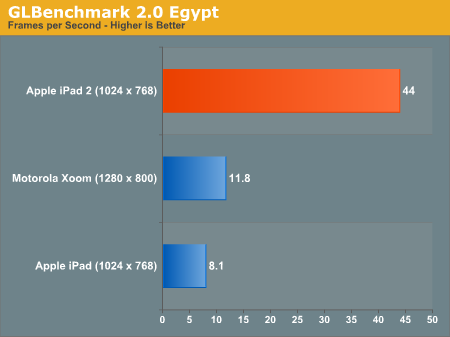Apple iPad 2 Preview
by Anand Lal Shimpi, Brian Klug & Vivek Gowri on March 12, 2011 6:01 AM ESTThe GPU: PowerVR SGX 543MP2
There are no spoilers here but the PowerVR SGX 535 in the original A4 is out, replaced by the new PowerVR SGX 543MP2. The 543 as a building block has a bit over twice the peak floating point throughput of the SGX 535. The MP2 just means there are two of these 543s working in tandem. The result is what Apple uses as the basis for their "9x faster" GPU claims. In practice the improvement should be less than that, but it's still enormous.
We've got GPU performance data coming, but I thought I'd take a slightly different route and show what one developer is using the extra horsepower offered by the A5 for.
Epic Games is a familiar face around these parts. We've used games powered by their Unreal Engine in our reviews for years now. More recently Epic has made a splash in the iOS world with the release of its Citadel demo and eventually Infinity Blade.
In time for the launch Epic updated Infinity Blade to have some special enhancements for iPad 2 owners. Rather than simply deliver a higher framerate for iPad 2 users, Epic enabled higher resolution textures and anti-aliasing. The resulting boost in image quality is astounding, particularly on the iPad 2's 1024 x 768 screen:

Mouse over to see Infinity Blade on the iPad 2
There's far more detail in the character models as well as the environment. Lighting looks improved and the AA is definitely appreciated.

Mouse over to see Infinity Blade on the iPad 2
The gallery below has a bunch of side by side shots showing the improvements made to Infinity Blade for the iPad 2 vs. what you get when you run the game on a first generation iPad.
As we mentioned before, the A5 (and iPad 2) are about enabling developers. In a year's time the PowerVR SGX 543MP2 will be found in the majority of iOS tablets on the market - and games are just going to get prettier from there.
Update: We've published a look at the performance of the PowerVR SGX 543MP2 running GLBenchmark 2.0 here. If you want a teaser, it's good:

















82 Comments
View All Comments
erple2 - Tuesday, March 15, 2011 - link
In the iOS case - they're synonymous. You can't get the "new" browser without also getting the new OS update.tipoo - Saturday, March 12, 2011 - link
In addition to software differences, each company also tweaks the design of the Cortex A9 to their liking. After ARM licences it out they can do pretty much whatever to it. So you might see Qualcomm adding cache, Nvidia doubling the bus, or whatever.metafor - Tuesday, March 15, 2011 - link
ARM core licenses do not allow you to modify the CPU design. ARM allows different options when configuring cache size and bus width and co-processors but only with their macro-generator. There's definitely flexibility, but it's not "whatever you want". There are limited flavors if you will of yummy goodness.Anand Lal Shimpi - Saturday, March 12, 2011 - link
While the underlying architecture between those devices may be similar, there are some differences. For example NVIDIA's Tegra 2 only has a single channel 32-bit LPDDR2 memory interface while TI's OMAP 4 has a dual-channel LPDDR2 memory interface.Tegra 2 also lacks an MPE (SIMD engine) while the OMAP 4 doesn't.
Take care,
Anand
tipoo - Saturday, March 12, 2011 - link
I'd be interested in a comparison between all these mobile processors. I understand its difficult since the iPad uses a different OS, but given the numbers where do you think it stands compared to Tegra 2 and the like?zhill - Saturday, March 12, 2011 - link
My understanding is that the ARM Cortex A9 is just an instruction set and architecture specification/chip design. Each company manufactures the actual chips themselves so they can make additional changes at the hardware level such as lithography, voltage, clock frequency, cache sizes etc. So they license the design from ARM, but build the silicon themselves so each design may vary in terms of actual implementation and performance.Software also certainly makes a difference.
winterspan - Saturday, March 12, 2011 - link
you are right to an extent. There are actually two different licenses, a manufacturing license and a "design" license. Basically, if you pay more for the design license, they can make a custom core that implements the ARM Cortex v7 instruction set. This is what Qualcomm does with their Snapdragon. Most of the other guys just have the manufacturing license and this enables mild adjustments, but essentially they all have to use a similar Cortex-A9 core.Not sure what the Apple cores are... Standard Cortex-A9 or something more custom from Intrinsity/Samsung?
jmmx - Sunday, March 13, 2011 - link
"If Apple iPAD 2, NVIDIA's Tegra 2, TI's OMAP 4 and Samsung's Exynos all use the same Dual Core ARM Cortex A9…"There is more to it than this. The simple fact is they do NOT "use the same Cortex A9." They each user their own implementation of the A9. Additionally, A9 is the core cpu design, but the chips are SoC chips "System on a Chip" That is, they contain a lot more than just the A9 CPU but other non CPU functional units as well.The configuration of these units can significantly affect performance.
This is my understanding of the situation. (Caveat - I am a software engineer not hardware.) Someone out there feel free to correct me if I am mistaken about this.
str1ke007 - Saturday, March 12, 2011 - link
Can the ipad2 be tetherd to an iphone ?? (so i can use the 3G data i allready pay for rather then paying for another sim/plan)kmmatney - Saturday, March 12, 2011 - link
There is no reason why you couldn't, and this is what I plan on doing. However I would like to know if the map and GPS apps work well on an iPad without 3G. Do you need to get a 3G for the GPS to work properly?